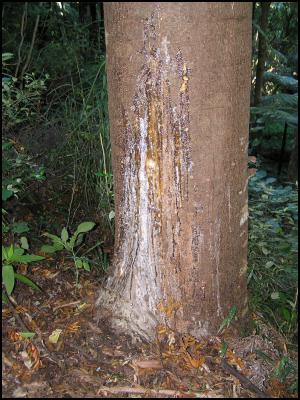Will Coromandel Kauri Survive? It’s Up to Us!
For immediate release
1 May 2013 2013
Will Coromandel Kauri Survive? It’s Up to Us!
Public concern for the fate of the kauri is gathering momentum. To date, however, most of the attention and resources have, of necessity, been focused on dieback-infected areas of Auckland, Northland and Great Barrier Island, with little happening to prevent this devastating disease spreading to kauri forests in the Coromandel Peninsula.
Coromandel Peninsula conservation group Kauri 2000 (www.kauri2000.co.nz) is so concerned about the threat that kauri dieback disease poses to kauri on the Peninsula that it is holding a series of free workshops on 18 and 19 May to raise public awareness of the disease and to help communities develop ways of protecting their local forests.
The programme will include presentations on what is known about kauri dieback disease and how to recognise it, what are the risks for the Coromandel, tools and techniques for preventing dieback spread, and ways in which locals can work together to help keep it out of their forests.
“Kauri dieback hasn’t been found on the Coromandel yet, but it only takes one pair of dirty boots, bike tyres or walking poles to spread the disease, and anyone coming from infected areas such as the Waipoua Forest, Great Barrier Island or the Waitakere Ranges is a potential carrier,” says Kauri 2000 chair Vivienne McLean. “This is a major environmental issue – and a threat to our tourism-based Peninsula economy, which is heavily dependent on our unique environment. No-one will want to come here to walk or run through forests of dead and dying kauri.”
“The best way to protect our forest ecosystems will be for our communities, marae, landowners, schools, businesses, environmental groups – in fact anyone who works in and loves the bush - to work together and come up with specific strategies that work best for their area,” she says.
At present there is no known cure for kauri dieback, a devastating phytophthera that spreads through soil movement. The key messages being promoted by the Kauri Dieback Response Team to prevent the spread of the disease are:
• Always stay on the track and off kauri
roots
• Clean your gear – remove every trace of soil
before and after forest visits. Clean your shoes, tyres and
equipment by scrubbing with hot soapy water.
“It’s
important to be proactive and prepare before the disease is
found here - the longer we can keep it out of the
Coromandel, the more time we buy for scientists to find
solutions,” says Ms McLean. “We need to strike a balance
so that holidaymakers, tourists, off-road runners and
bikers, contractors, pig hunters, trampers and the like can
still access the forests, but understand what they need to
do to protect them.”
The workshops are being run with
support from the Kauri Dieback Response Team, the Department
of Conservation and the Waikato Regional Council.
Venues and times are as follows:
• 1-3.30 pm Saturday 18 May -
Grahamstown Community Centre, Pollen Street, Thames
•
1- 3.30 pm Sunday 19 May - Coromandel Area School Hall,
Woollams Ave, Coromandel
• 6 – 8.30 pm Sunday 19 May
- Whitianga Town Hall, Monk Street, Whitianga
Everyone
is welcome to attend any of these free workshops. (A gold
coin donation to help with costs would be appreciated). Hand
outs, tea and coffee will be provided on the day. To help
get an idea of numbers please register your interest with
the Kauri 2000 Trust by Wednesday 15 May – phone 07 866
0468 or email info@kauri2000.co.nz.
For more information go to www.kauri2000.co.nz
or www.kauridieback.co.nz.
Bleeding lesion

Symptoms of kauri dieback may (but not always) include bleeding at the base of the tree, yellowing leaves, thinning canopy, dead branches and sudden death. Diseased trees do not always show all the symptoms, however, and other diseases may show similar effects. Image courtesy of Auckland Council
ENDS


 Gordon Campbell: On The Public Sector Carnage, And Misogyny As Terrorism
Gordon Campbell: On The Public Sector Carnage, And Misogyny As Terrorism National Maori Authority: Maori Authority Warns Government On Fast Track Legislation
National Maori Authority: Maori Authority Warns Government On Fast Track Legislation NZ Government: Comprehensive Partnership The Goal For NZ And The Philippines
NZ Government: Comprehensive Partnership The Goal For NZ And The Philippines DoC: Canterbury Spotted Skink In Serious Trouble
DoC: Canterbury Spotted Skink In Serious Trouble Te Pāti Māori: Oranga Tamariki Cuts Commit Tamariki To State Abuse
Te Pāti Māori: Oranga Tamariki Cuts Commit Tamariki To State Abuse NZCTU: Inflation Data Shows Need For A Plan On Climate And Population
NZCTU: Inflation Data Shows Need For A Plan On Climate And Population Statistics New Zealand: Annual Inflation At 4.0 Percent
Statistics New Zealand: Annual Inflation At 4.0 Percent


